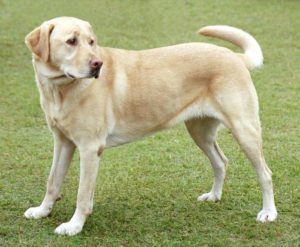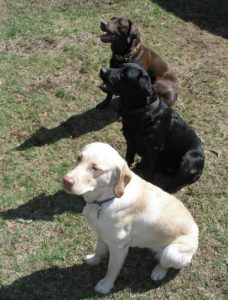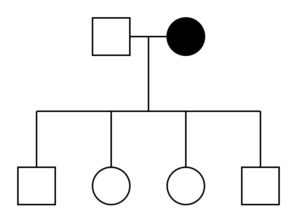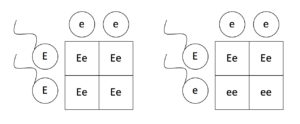51 Yellow fur color: a recessive trait
Yellow color in dogs
Labrador retrievers don’t only come in brown and black, they also come in yellow. Yellow color in labs is caused by variations in a different gene: MC1R. This gene controls the production of the melanocortin 1 receptor protein. MC1R is located on chromosome 5 in dogs (Schmutz, 2001).

Melanocytes make two forms of melanin, eumelanin and pheomelanin. The relative amounts of these two pigments help determine the color of an individual’s hair and skin. Individuals who produce mostly eumelanin tend to have brown or black hair and dark skin that tans easily (in humans). Eumelanin also protects skin from damage caused by ultraviolet (UV) radiation in sunlight. Individuals who produce mostly pheomelanin tend to have red or blond hair, freckles, and light-colored skin that tans poorly. Because pheomelanin does not protect skin from UV radiation, people with more pheomelanin have an increased risk of skin damage caused by sun exposure.
The melanocortin 1 receptor controls which type of melanin is produced by melanocytes. When the receptor is activated, it triggers a series of chemical reactions inside melanocytes that stimulate these cells to make eumelanin. If the receptor is not activated or is blocked, melanocytes make pheomelanin instead of eumelanin. This means that if the receptor is working correctly and is turned on, dark pigment will be produced. If the receptor is not functional or is not turned on, light pigment will be produced.

Schmutz et. al. (2002) determined the DNA sequence for the MC1R gene from dogs of various colors. They determined that black and brown dogs all have one allele of MC1R, while yellow and red dogs have a different allele. The allele that leads to yellow or red color has a premature stop codon which results in a shorter-than-normal protein. This protein would be predicted to not function correctly. Remember that when the melanocortin 1 receptor is not functioning correctly, light pheomelanin pigment is produced and not dark eumelanin.
Dogs that are homozygous for the functioning allele of MC1R (which would cause eumelanin to be produced) are dark in color. Dogs that are homozygous for the non-functioning allele (which would cause pheomelanin to be produced) are light in color. Dogs that are heterozygous are dark in color. What does this tell you about which allele is dominant? If you said “the dark allele is dominant because it covers up the light allele”, you’re correct. We will use “E” to represent the genotype at MC1R because the dominant phenotype in this case is the production of eumelanin. Dogs that have the genotype EE or Ee will produce eumelanin and be dark. Dogs that have the genotype “ee” will produce pheomelanin and be light.

The cross shown in Figure 15 can also be shown as a Punnett square. Since we are unsure whether the male dog has the genotype “EE” or “Ee”, we have to make two Punnett squares. Since all of the puppies resulting from this cross were black, we would predict that the first Punnett square shows the cross. However, it is possible that the second Punnett square is correct. There are only 4 puppies, so it’s not hard to imagine that they could all be black even though the Punnett square predicts only 50% black. It would be comparable to flipping a coin 4 times and getting 4 heads in a row. Getting 4 heads in a row is less likely, but definitely possible.

It is very important to note here that yellow dogs still have the TYRP1 gene, even though they are not black or brown!
Human Connection
Common variations (polymorphisms) in the MC1R gene are associated with normal differences in skin and hair color. Certain genetic variations are most common in people with red hair, fair skin, freckles, and an increased sensitivity to sun exposure. These MC1R polymorphisms reduce the ability of the melanocortin 1 receptor to stimulate eumelanin production, causing melanocytes to make mostly pheomelanin. Although MC1R is a key gene in normal human pigmentation, researchers believe that the effects of other genes also contribute to a person’s hair and skin coloring.
The melanocortin 1 receptor is also active in cells other than melanocytes, including cells involved in the body’s immune and inflammatory responses. The receptor’s function in these cells is unknown.

Photo credit: dusdin on flickr; from Wikipedia.
Resources
Unless otherwise noted, images on this page are licensed under CC-BY 4.0 by OpenStax.
OpenStax, Biology. OpenStax CNX. May 27, 2016 http://cnx.org/contents/s8Hh0oOc@9.10:FtsD6vMd@3/Mendels-Experiments
OpenStax, Biology. OpenStax CNX. May 27, 2016 http://cnx.org/contents/s8Hh0oOc@9.10:sbdXt0s3@4/Laws-of-Inheritance
OpenStax, Biology. OpenStax CNX. May 27, 2016 http://cnx.org/contents/s8Hh0oOc@9.10:zLLYW2hj@5/Extensions-of-the-Laws-of-Inhe
Human Connection – information about MC1R: “MC1R” by Genetics Home Reference: Your Guide to Understanding Genetic Conditions, National Institutes of Health: U.S> National Library of Medicine is in the Public Domain
Schmutz SM, Moker JS, Berryere TG, Christison KM, Dolf G. 2001. An SNP is used to map MC1R to dog chromosome 5. Anim Genet. 32(1):43-4.
Schmutz SM, Berryere TG, Goldfinch AD. 2002. TYRP1 and MC1R genotypes and their effects on coat color in dogs. Mammalian Genome 13, 380-387.


Feedback/Errata